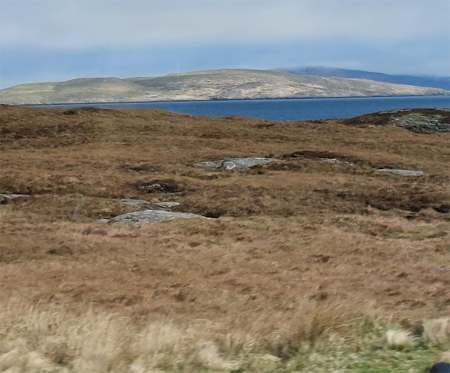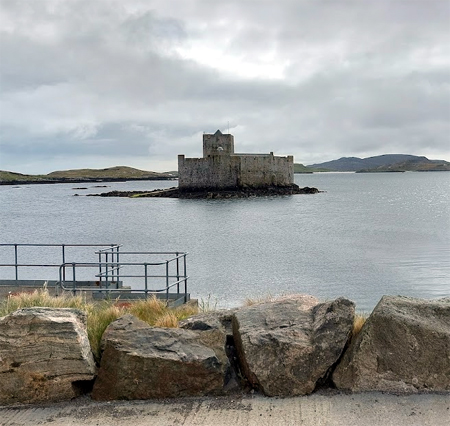-
The Outer Hebrides South
The Outer Hebrides—aka The Edge of the Known World—is a place I never thought I’d go, or even thought about going to, but there I went, and with a great bunch of people.
My tourmates were all swell folks and wonderful travelling companions, and Brightwater—the company we travelled with—was terrific, and we had an outstanding tour manager and coach driver, and I am not saying this just because I told some of them about this blog and worry they might read it.
The trip began with a bus ride from Glasgow (population 635,130) to Oban (population 1,840) where we caught a ferry to Lochboisdale (population 300), so you see, when I say it’s the ends of the earth, it’s not an exaggeration.

A nod to you GoT fans Oban was nice. A little place you could spend an afternoon in and feel like you’ve pretty much done it. Therefore, it was good that we had only an hour before we had to be at the ferry terminal for our five-and-a-half-hour cruise.

Oban: pleasant enough, but that’s just about it The trip was pleasant, however, because the Fair-Weather Fairy came with us. It was sunny and mild, and the scenery was spectacular. An announcement, as we left the dock, told us what alarm we needed to listen for to know if the boat was sinking. I would expect we could figure out the boat was sinking by the water rushing in through the windows, but what do I know?

View from the Ferry, approaching South Uist Island Back on solid ground, we drove to the island of Benbecula (population 1,249 – that’s the whole island!) and on to the Dark Island Hotel near the town of Linaclate (population unknown).
I’m not sure what I expected to find at the edge of the earth—people living in stone huts and bartering with chickens, perhaps—but what I found was a very civilized (though quiet) place, with indoor plumbing and WiFi. To say it was in the middle of nowhere would be redundant because everything on the Outer Hebrides is in the middle of nowhere.

Lotta water, lotta sheep, no trees And we were there on Sunday, when everything—including public toilets—was closed. This is why our tour ended on Friday. Granted, we arrived on Sunday, but we had dinner at the hotel, where they have operating—and open—toilets. The actual touring part of the tour didn’t start until Monday, when things opened back up.
The hotel had small rooms and few amenities, but excellent food and service, so there was nothing to complain about. The staff even loaned me a lighter so I could smoke one of the cigars I bought in Ayr, of all places.
Sitting in the Beer Garden out back, the isolation was palpable, and made me wonder if the locals even noticed the COVID lockdowns. The land was mostly covered by water, birds, sheep, and no trees. The sheep were everywhere, climbing the rock faces, grazing the scrubland, and lounging in peoples’ driveways. This did not make it look bucolic, however; the vast vistas were simply barren, not something I would even generously label as having stark beauty.

Stark, yes, beautiful, matter of opinion To start our tour, we drove back the way we had come the day before, driving over the causeway to Eriskay (population 143—no, I’m not kidding, that’s for the whole island), where we saw Prince Charlie’s Bay—a stunning beach in the middle of the barren wilderness—to catch a ferry to Barra. In Barra, we watched a plane land on a cockleshell beach, then went to the graveyard where Sir Compton MacKenzie—the author of Whisky Galore!—is buried. Sir Compton is revered like a saint there, so going to his grave was a bit of a pilgrimage. After that, we went to a community café for lunch—which we dubbed The Café at the End of the Universe—and then we drove over another causeway to the island of Vatersay.

The grave of Sir Compton MacKenzie Vatersay was mostly impossibly narrow roads and magnificent beaches. I thought Prince Charlie’s Beach was amazing, but you can’t swing a cat without hitting a beach here, each one more amazing than the last. What they all have in common, however, is that no one is swimming at any of them; it’s too cold for a bikini.
We basically travelled from one end of the small island to the other, stopping to photograph spectacular views and/or memorials to brave dead people. One consisted of the remains of a sea plane that had crashed in 1944, but they didn’t build a memorial, they just left the jumble of metal and put up a plaque. It’s like they couldn’t be bothered to clean up the site, so they just left it and called it a memorial, much like the highway department neglecting to mow, and calling the resulting tangle of over-growth a Natural Area. (I am all in favour of the latter, however.)

That’s not a memorial, that’s just being lazy After running out of land, we slowly wended our way back to the ferry, with a pit stop at Castle Bay (where, oddly enough, there’s a castle in the bay) for a cup of tea. Our group, in addition to being a swell bunch of folks, is also quite keen. We had forty-five minutes to explore the town and provide an infusion of tourist dollars (pounds?) into the Castle Bay (population 300) economy, but we returned early, and it occurs to me that we have been consistently early, right from pick-up on Sunday morning, which helps to move things along.

Castle Bay; the clue is in the name From Castle Bay we continued the circular route around the island of Barra (there’s only one road) back to where we came from.
The next morning, we checked out of the Dark Island Hotel and travelled to Harris, the lower half of the Island of Lewis and Harris (one island, two names), which involved another ferry, but with a twist. Literally. The stretch of water is not very wide, but the ship has to zig-zag across because of the shallows and the rocks.

As the crow flies vs the ferry route The scenery on Harris is very different. It was flat and bleak at Benbecula, then further south it was rolling hills, but in both places the ground was covered in scrub brush and no trees. Harris, however, resembles an endless slagheap. There is very little vegetation and even less character to the land. Without the sun, it would be very, very atmospheric (read: desolate).

It pretty much all looked like this But there were beaches! We’d turn a corner and there was a beach, then we’d turn another corner, and there was another, even more beautiful, beach. This went on for some time, until they announced a final beach at Luskentyre. By then, I really thought I couldn’t be impressed by yet another beach, but it was stunning. It is rated in the top 25 beaches in the world, and I can see why they saved that one until last—if we had seen it first, any other beach would have paled in comparison.

Some of the many beaches After that, we continued to Tarbert for a rest stop. We had an hour and a half there when about twenty minutes would do, but at least we were able to get a cup of coffee and a muffin.
On the run up to our hotel at Stornoway we had so many photo ops that, every time the bus slowed down, I thought, “Please, not another scenic stop!” But I paid for it, so I always got off. Generally, it was a Bonnie Prince Charlie monument, because you couldn’t spit without hitting something related to Bonnie Prince Charlie.
Our final stop of the day was the ruins of an old church. I didn’t hold out much hope (you can only remain excited about looking at old stuff for so long) but it was genuinely spectacular. This, however, was mostly down to the bright sunshine and clear blue skies, which made the scenery, if not the temperature, reminiscent of mid-summer.

Yeah, yeah, yeah, the church is really old, but look at that sky!